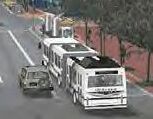
Light Rail Now and Walkable Neighborhoods (LRN) can be contacted at: Light Rail Now! |
A frequent canard repeated by light rail opponents is the accusation that light rail transit (LRT) projects routinely experience severe cost overruns. Thus, they claim, projected costs of new projects are supposedly severely "underestimated". Wendell Cox, Thomas Rubin, and other rail opponents claim, for example, that "80%" or more of light rail projects experience serious cost overruns. The result is a potent scare tactic to alarm the public and turn voters away from light rail. In mid-1999, the federal General Accounting Office, or GAO, published its own analysis of a number of major public transit projects. The GAO report, "Mass Transit – Status of New Starts Transit Projects With Full funding Grant Agreements" (GAO, Aug. 1999), particularly scrutinizes the issue of whether the projects had adhered to their budget and schedule guidelines. A review of the GAO's document indicates that, in contrast with the claims of Rubin and other zealous LRT opponents, the budget record of light rail projects has largely been admirable, particularly when compared with other alternative large public-transit undertakings such as "Bus Rapid Transit" (BRT) projects. The document is available at http://www.gao.gov/archive/1999/. Just find document RC 99240 on the list.
Transit Projects Reviewed Basically, the document reviews new transit projects in 14 cities. These can be categorized into Rail Rapid Transit (RRT), Regional Passenger Rail (RPR) (commonly called "commuter rail"), Bus Rapid Transit (BRT), and Light Rail Transit (LRT), as indicated in the table below. All Projects Reviewed
In all , 4 RRT, 1 RPR, 2 BRT, and 7 LRT projects were reviewed by the GAO. Of these, 100% – every single one – of the LRT projects came in at or below estimated budget. Projects With Cost Overruns The projects which were over budget were the two BRT projects, the single RPR project, and three of the RRT projects. in other words, both of the BRT projects reviewed were over budget. So much for the claims by Road Warriors like Cox and Rubin that BRT will save money and avoid budget overruns! Incidentally, the one RRT project which did not experience an overrun was LA's Red Line extension.
Here is more detailed analysis on the six transit projects which were cited for budget overruns in the GAO report. The following is a tabulation of the percentage overrun – i.e., the percentage by which the original cost was exceeded. Projects With Cost Overruns
Regarding these projects with overruns, we note the following: · A BRT project – Boston's South Boston Piers Transitway – racked up the highest single percentage cost overrun. · A rail transit project – Maryland's MARC regional passenger rail ("commuter rail") Frederick ext. – racked up the lowest percentage cost overrun (of those projects which had overruns). · The percentage cost overrun of both the Houston BRT (HOV) project and the Atlanta RRT project were approximately in the same ballpark of around 7%. In all fairness, it should be noted that Houston Metro's HOV project cost and schedule delay problems apparently stemmed from delay brought on by contractor disputes with the agency, which produced a 2-year delay in implementation. Delay costs money. However, the problems facing the Boston BRT project were different, and are worth noting in detail in view of the intensive promotion of BRT by the Federal Transit Administration and various elements within the highway industry. The Boston plan is much closer to what might be considered "high-level" BRT, including fancy new multi-articulated vehicles. According to the GAO, some reasons for actual and potential cost overruns are enumerated as follows:
· Design problems: "...the original baseline cost estimate was based on the project's early design, which has since required modification." (As we've previously observed, BRT promoters habitually lowball design and cost aspects.) · Utilities relocation problems: "... complications with the design for relocating utilities, and differing site conditions." (Downplaying or ignoring utilities relocation issues for BRT is one of the more common practices in the lowballing process.) · Vehicle facility costs: "... whether to build a new vehicle maintenance facility or expand an existing one ..." (As we have represtedly noted, BRT enthusiasts typically lowball costs by claiming that existing facilities can be used and new ones are unnecessary) · Rolling stock cost overruns: "a higher-than-anticipated unit cost for the vehicles..." (Remember: these are largely newly designed, somewhat experimental, and fairly untested vehicles with rather complex mechanical features.) The GAO report also repeatedly cites land acquisition costs which are exceeding estimates. Again, this suggests the possibility that BRT's actual spatial requirements both for ROW and stations were underestimated in the familiar cost-lowballing process that characterizes the work of many BRT promoters and their consultants. All told, this information constitutes a tremendous refutation of the widespread "cost overrun" claims about LRT (and the supposed virtues of BRT) promulgated by many anti-rail zealots. Moral of the story: "Rubber-tire rapid transit" has about the same propensity of cost overruns as major rail transit projects. if you're looking for a "magic bullet" to eliminate cost overruns, BRT ain't it. Rev. 2001/07/17 | ||||||||||||||||||||||||||||||||||||||||||||||
|
|
|||||||||||||||||||||||||||||||||||||||||||||||